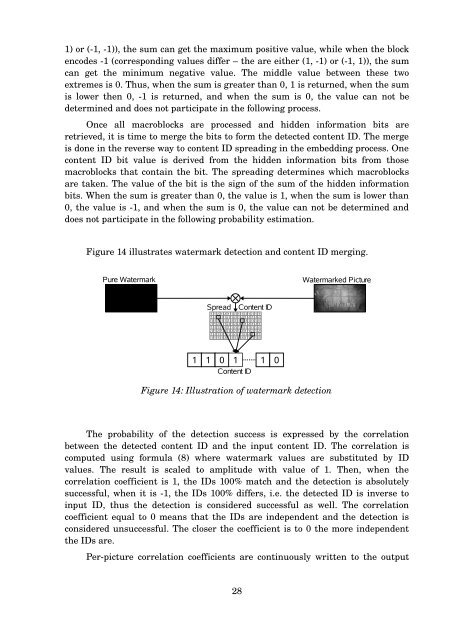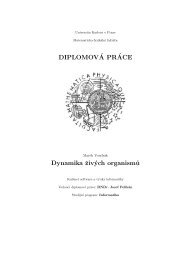MASTER THESIS Video Watermarking - Computer Graphics Group ...
MASTER THESIS Video Watermarking - Computer Graphics Group ...
MASTER THESIS Video Watermarking - Computer Graphics Group ...
You also want an ePaper? Increase the reach of your titles
YUMPU automatically turns print PDFs into web optimized ePapers that Google loves.
1) or (-1, -1)), the sum can get the maximum positive value, while when the block<br />
encodes -1 (corresponding values differ – the are either (1, -1) or (-1, 1)), the sum<br />
can get the minimum negative value. The middle value between these two<br />
extremes is 0. Thus, when the sum is greater than 0, 1 is returned, when the sum<br />
is lower then 0, -1 is returned, and when the sum is 0, the value can not be<br />
determined and does not participate in the following process.<br />
Once all macroblocks are processed and hidden information bits are<br />
retrieved, it is time to merge the bits to form the detected content ID. The merge<br />
is done in the reverse way to content ID spreading in the embedding process. One<br />
content ID bit value is derived from the hidden information bits from those<br />
macroblocks that contain the bit. The spreading determines which macroblocks<br />
are taken. The value of the bit is the sign of the sum of the hidden information<br />
bits. When the sum is greater than 0, the value is 1, when the sum is lower than<br />
0, the value is -1, and when the sum is 0, the value can not be determined and<br />
does not participate in the following probability estimation.<br />
Figure 14 illustrates watermark detection and content ID merging.<br />
<br />
<br />
<br />
<br />
<br />
<br />
<br />
<br />
<br />
<br />
<br />
<br />
<br />
Figure 14: Illustration of watermark detection<br />
The probability of the detection success is expressed by the correlation<br />
between the detected content ID and the input content ID. The correlation is<br />
computed using formula (8) where watermark values are substituted by ID<br />
values. The result is scaled to amplitude with value of 1. Then, when the<br />
correlation coefficient is 1, the IDs 100% match and the detection is absolutely<br />
successful, when it is -1, the IDs 100% differs, i.e. the detected ID is inverse to<br />
input ID, thus the detection is considered successful as well. The correlation<br />
coefficient equal to 0 means that the IDs are independent and the detection is<br />
considered unsuccessful. The closer the coefficient is to 0 the more independent<br />
the IDs are.<br />
Per-picture correlation coefficients are continuously written to the output<br />
28
















